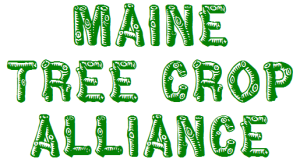…and the “Intrastate” Connections That Have Kept It Alive
—by Jack Kertesz, November 2020
This is not a story of the discovery of some ancient apple variety, nor is it the story of one that will alter the course of future plant breeding. It is the story of a chance “discovery” of a seedling of some merit, in particular for the homeowner or small orchardist.
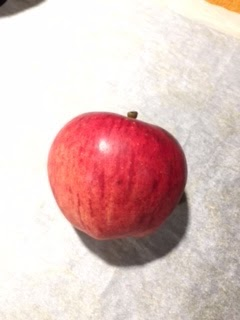 The story begins in October of 1987, when my particular orbit was Waterville-centric. Heading north on the entrance ramp off of Kennedy Memorial Drive, I spotted a fairly good sized tree bearing apples, so I stopped to collect some. (As I have found in many other instances, the “apples” emerged from a sucker at the base of an intentionally planted, but neglected crab apple, likely planted for highway “beautification”.)
The story begins in October of 1987, when my particular orbit was Waterville-centric. Heading north on the entrance ramp off of Kennedy Memorial Drive, I spotted a fairly good sized tree bearing apples, so I stopped to collect some. (As I have found in many other instances, the “apples” emerged from a sucker at the base of an intentionally planted, but neglected crab apple, likely planted for highway “beautification”.)
We had a fairly robust Fall Fruit Swap in those days, the reciprocal event for the Scionwood Exchange, and I was pretty passionate about getting folks to try this new found apple. My friend, Tom Vigue, was eager to sample such and we agreed that it was worthy of scionwood distribution in the Spring. That did happen, and while there are no records of where it may have gone, Tom managed to have a graft take, and has grown and enjoyed it ever since.
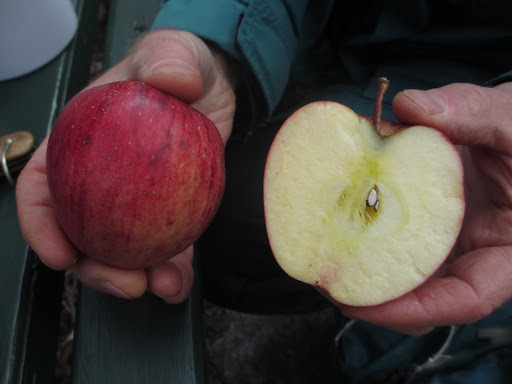 The following year, entering the highway again, I noticed that this tree had suffered considerable storm damage. I’d like to think that parts of the tree were still salvageable, but on a return trip I found that it had been cut completely down and in ensuing years, nothing sprouted from the base. (it is likely that a herbicide was used, perhaps not wanting to grow deer food next to the interstate was the reason for its demise).
The following year, entering the highway again, I noticed that this tree had suffered considerable storm damage. I’d like to think that parts of the tree were still salvageable, but on a return trip I found that it had been cut completely down and in ensuing years, nothing sprouted from the base. (it is likely that a herbicide was used, perhaps not wanting to grow deer food next to the interstate was the reason for its demise).
I find this rather intriguing as a similar instance happened just a half a mile down the road, where another “found” apple was whacked to the ground. I also experienced this on several other occasions, so there is a lesson here: if you want to save it, get it grafted!
Over the years I have been reminded of what a murky name I gave to this apple, but I originally did not want to have anyone confuse this with an existing cultivated variety, so maybe I accomplished that. More importantly, this apple was “saved”, in part through my rather serendipitous efforts and Tom’s follow through. Tom’s recent harvest suggests it’s value. Below are photos of two bushels of cosmetically great apples and one, primarily low graded for defects, mostly bird pecks.
What follows is from an 1988 MTCA Newsletter:
I-95 APPLE
The 1-95 ‘mystery’ apple (a sucker from a crab) mentioned in a previous newsletters put on a sizable crop of medium size fruit this year and consequently broke under recent snow loads. Enough of it remains to produce future fruit and scions, but highway maintenance crews might seek its swift removal. This year’s apples were coarse-fleshed (grainy), with dry, russet-type skins. While not terribly attractive to tongue or eye, they had a low incidence of insect damage. Sooty blotch is evident on the skins and automotive pollutants may have assisted in the development of these other traits. I’ll have samples of them on hand at the Fruit Swap. They may prove to be no one’s favorite. I’m intrigued by wild fruit that isn’t insect infested and can grow under unfavorable conditions. I’m also reminded to watch out for horticultural ‘accidents’ of both kinds — these things may be as hard to spot as they are easy to disappear.
And finally, here are some photos and notes from Tom Vigue:
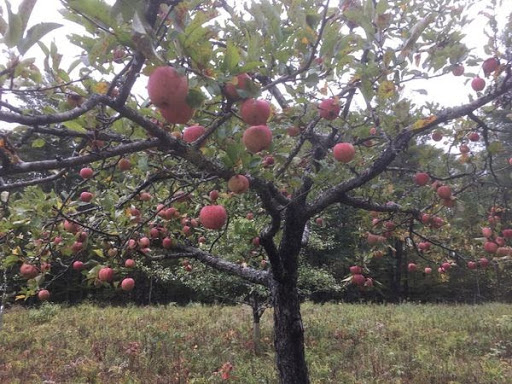 “So – what is this apple really like?
“So – what is this apple really like?
“Here are two photos. The first is my I-95 tree, The second is the harvest. About two-thirds dessert quality fruit, and one-third cull, although many of the culls are due to molding bird pecks. This is completely without intervention, no maggot traps, no Surround, or anything else.
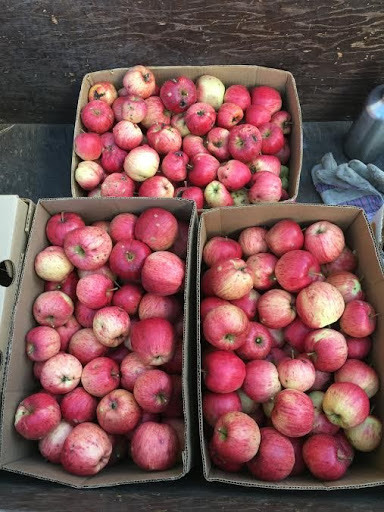 “Someone who saw this apple in person kind of sneered and said very condescendingly, “Oh, it’s a Red Delicious seedling.” Well, very likely, it is, since commercial propagators sometimes do use that source of seedlings for grafting ornamental crabs, but other than a vague shape resemblance, there is no similarity.
“Someone who saw this apple in person kind of sneered and said very condescendingly, “Oh, it’s a Red Delicious seedling.” Well, very likely, it is, since commercial propagators sometimes do use that source of seedlings for grafting ornamental crabs, but other than a vague shape resemblance, there is no similarity.
“The I-95 is not susceptible to the wide range of problems that plague its likely parent, perhaps due in no small part to its rather thick and somewhat leathery skin. Therefore it produces a high percentage of dessert quality fruit without intervention. Its crisp flesh is aromatic and has a very pleasing tart-sweet flavor. It makes a superb dried apple. The main objection one might have is that the skin is somewhat dry in the mouth—the more you chew it, the more you have to chew it some more. But that is a small price to pay for all the great quality fruit. Ripening in October, and keeps well until late winter.”
Final comments from Jack:
I have known Tom Vigue for a long time now and from my experience, he has a learned palette. He seeks the good and simple rather than the gourmet. If he likes something, it should be duly noted, as his tastes run to the practical as well as the palatable. The I-95 apple is nothing extraordinary, it is more ordinary. It is a stumble upon find that I believe that anyone with a little gumption and curiosity can duplicate. Ordinary fruit, for ordinary folks, from neglected trees. Keep looking, as there are plenty of these examples out there.

